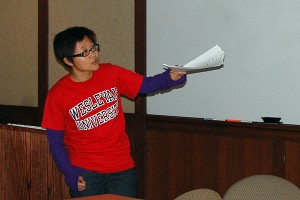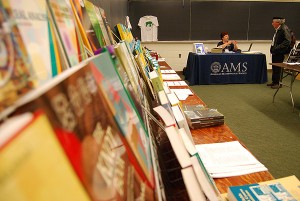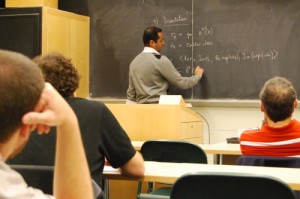220 Scholars Present Research at Mathematical Society Meeting

During a session on algebraic topology, graduate student Weiwei Pan spoke to dozens of mathematical scholars from around the world on “Categorified Bundles and Classifying Spaces.”
Pan was one of 220 speakers who presented math-related talks during the 2008 Eastern Sectional Meeting of the American Mathematical Society held Oct. 11-12 at Wesleyan. More than 300 participants registered.
“One of the best things about being a mathematician is that there are people all over the world who share your interests, and that mathematics can be a common language for people from very different backgrounds and heritages,” says Karen Collins, professor and chair of the Mathematics and Computer Science Department. “We were very excited to have such strong and diverse group of mathematicians here this weekend.”
The conference was divided into several “special sessions” on a particular subject. Topics included number theory, low-dimensional topology, fractals, convex and integral geometry, geometric function theory, partial differential equations, computability theory and effective algebra, metric measure spaces, the history of mathematics, and several others.
Ed Taylor, associate professor of mathematics; Petra Bonfert-Taylor, associate professor of mathematics; and Katsuhiko Matsuzaki, the Van Vleck Visiting Researcher in mathematics, invited scholars from the Tokyo Institute of Technology, Queens College, the University of Michigan, Boston College and Syracuse University to speak on “Geometric Function Theory and Geometry.” These topics intersect the mathematical fields of geometry and analysis, a theory that underlies calculus.

“Geometric function theory and geometry are undergoing a tremendous surge of interest and activity, in no small part owing to an influx of talented young mathematicians who are just entering the field,” Taylor explained. “As organizers, we decided to predominately invite such young talented mathematicians from both around the country and from Europe.”
Mark Hovey, professor of mathematics, co-organized a special session on algebraic topology in honor of Bill Singer, professor of mathematics at Fordham University, who is an expert in algebraic topology, homological algebra. Singer spoke on “Rings of Symmetric Functions as Algebras” during the session.
Constance Leidy, assistant professor of mathematics, co-organized a sessions on low-dimensional topology; Wai Kiu Chan, associate professor of mathematics, and David Pollack, associate professor of mathematics, coordinated sessions on number theory; and Philip Scowcroft, professor of mathematics, and Carol Wood, the Edward Burr Van Vleck Professor of Mathematics, co-organized sessions on model theory and its applications.
“For each special session, this conference brought together many researchers who are working on the same kind of problems. That’s always a real treat, because in everyday life, a mathematician may be working alone or in a small group,” Collins says. “Collaborations between groups can be very exciting, particularly when one group can solve one part of a problem, and another can solve a different part, so that together they achieve a beautiful answer. Conferences like this one support the whole mathematical enterprise.”

In addition to dozens of special sessions, the conference included four invited addresses by Pekka Koskela, of University of Jyväskylän; Monika Ludwig of the Polytechnic Institute of New York University; Duong Hong Phong of Columbia University; and Thomas Warren Scanlon of the University of California, Berkeley.
Participants also had an opportunity to browse the American Mathematical Society book sale, ongoing throughout the conference.
“This meeting . . . was the absolutely perfect sectional meeting. There were great special sessions in which many local people were involved both as organizers and as participants,” says Lesley Sibner, associate secretary of the Eastern Section of the American Mathematical Society, and a professor of mathematics at Polytechnic Institute of New York University. “All of the invited speakers were involved with special sessions which made the invited addresses all the more interesting, and the invited addresses were excellent.”
Wood credits the Mathematics and Computer Science Department’s staff and Instructional Media Services for helping to make the conference run smoothly. The sectional meeting’s full program is online at http://www.ams.org/amsmtgs/2154_progfull.html.

